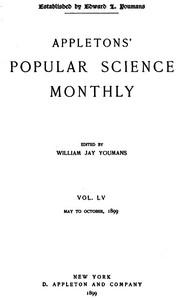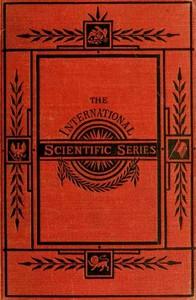|
|
Read this ebook for free! No credit card needed, absolutely nothing to pay.Words: 39480 in 9 pages
This is an ebook sharing website. You can read the uploaded ebooks for free here. No credit cards needed, nothing to pay. If you want to own a digital copy of the ebook, or want to read offline with your favorite ebook-reader, then you can choose to buy and download the ebook.

: Appletons' Popular Science Monthly August 1899 Volume LV by Various Youmans William Jay Editor - Science Periodicals; Technology Periodicals@FreeBooksWed 07 Jun, 2023 d become merged in the surrounding populations, is undoubtedly a fact, but does not in any way affect the relative purity of the "remnant" which has remained true to its faith. It certainly does not affect the very important fact that the ancestry of at least five per cent of Jews at the present day can not have married proselytes, owing to the rigid requirements of Jewish law. So far as I understand the latter part of Professor Ripley's second article, he appears to contend that the remarkable similarity of the Jewish physiognomy all over the world has no force in proving their racial unity. This is, of course, from the popular point of view, the strongest argument which Professor Ripley has to meet. Speaking generally, one can always tell a Jew or Jewess by the Jewish features and expression. So marked is this that Andr?e mentions an instance where the negroes of the Gold Coast even distinguish between other whites and Jews by its means, saying not "Here are three whites coming," but "Here are two whites and a Jew." So marked a community of expression and appearance would be, to an ordinary mind, an absolute proof of unity of race, but Professor Ripley prefers to judge by the skull beneath, rather than by the expression and features on the surface. He hints at some obscure embryological process by which Jewish mothers can stamp on their offspring the Ghetto expression, whatever be the racial formation of skull. According to him, it would appear that noses are more plastic in this regard than skulls. I do not quite see how this would work out in detail. Are we to suppose that a pair of snub-nosed converts to Judaism would produce offspring with the characteristic Jewish nose because the lady convert had her imagination influenced by the hook-noses surrounding her? Are we to suppose that round heads can only beget round heads, but that snub noses can produce the hooked variety as a mere result of imagination? Mere expression one could understand could be produced by sociological causes, and it is certainly my impression that Jews who mix more with their fellow-citizens lose a good deal of the characteristic Jewish expression, but that Jewish features should be influenced in this way few people would be prepared to allow. Jewish "nostrility," as I have termed it, and the "Jew's eye," can not be affected by change of environment. They can be affected, I grant, by admixture with races snub-nosed or dull-eyed, but as they have persisted throughout the ages they are themselves a striking proof of the absence of such admixture. Altogether I remain unconvinced by Professor Ripley's arguments as to any large admixture of alien elements among contemporary Jews as unvouched for by history, and not necessarily postulated by anthropology. The broad skulls of the Jews, if they differ from those of earlier date , are due to the development of Jewish capacity, owing to their consistent attention to education and to the conditions under which they have pursued the struggle for existence. The persistence of Jewish features throughout the ages and the existence of an influential minority who are not allowed by Jewish law to marry outside their race is further proof of the position for which I have throughout contended. If there has been a tolerably large admixture of Jewish and alien blood throughout the Christian centuries it has been by conversions to Christianity or Islam, not by adoption of Judaism, and it is confirmed by history that the offspring have wandered away from the Jewish race and have not affected the more conservative remnant. The significance of this result for the science of anthropology can not be overrated. The great question of the science is that expressed by Dr. Galton as "the struggle between Nature and nurture"--the difference that social influences can produce on men of the same race. Jews afford the science almost the sole instance in which this problem can be studied in its least complex form. My own investigations have shown that social environment has a direct influence on such anthropometrical data as height and breathing capacity. The Jews of the West End of London, though of the same race as those of the East End, are superior in height and other external qualities, and this superiority can thus be shown to be due entirely to nurture. Similarly, if the argument I have previously adduced is correct, the brachycephalism of the Jew is a proof that intellectual development produces broad heads, and that, roughly speaking, the cephalic index is a key to intellectual capacity. I should rather reverse Professor Ripley's main contentions: breadth of skull is not a criterion of race, but of intellectual development; whereas features, which are not directly influenced by social or intellectual characteristics, are the true index to racial purity. SOME PRACTICAL PHASES OF MENTAL FATIGUE. Modern studies in neurology have contributed much to our knowledge of the function of the nervous system as a whole and of its several parts, and also of the relation of psychical activity to cerebral conditions and processes. The architecture of the neural mechanism delineated by these investigations is not only interesting in itself on account of the marvelous unity of things apparently diverse, but it is at the same time suggestive respecting its office as the physical instrument through which mind must express itself in this world. Psychologists now quite generally conceive of a living being, human or otherwise, as a reacting organism, receiving impressions from its environment and responding to them in some characteristic manner. To be fitted for this office an individual must be provided with appliances alike for the reception of stimulations and for their transformation into incitements to muscular activity. In the human species Nature has ordained that action need not follow immediately and inevitably upon any sense stimulus; fortunately, it may be deferred, so that when it does finally occur it will be the resultant of any given present impression modified by others previously received and treasured up in memory, as we say. To accomplish this really great feat, Nature had to devise an elaborate contrivance, interposed between incoming messages and outgoing impulses, to act as a moderator or transformer of a very extraordinary and intricate character--the central nervous system, comprising the brain and spinal cord. That it may be able to meet the requirements of its office, this system must be equipped with two principal kinds of apparatus--cells, which will serve as storehouses of energy to be employed in keeping the machinery running, and association fibers or pathways, which will put any one cell into communication with others in the cerebral community. The item which will engage our attention principally here relates to the primary function of the nerve cell--to store up vital forces in the form of highly unstable chemical compounds, which may upon slight disturbance be broken down, the static energy represented in their union thus becoming dynamic. Those who have given special attention to the matter seem to agree that all activity, physical as well as mental, involves the expenditure of a portion of this energy. It may perhaps be mentioned in passing that when this conception was first being presented some persons hastily constructed the theory that what people had been calling mind was nothing more nor less than a certain mode of manifestation of this mysterious but yet physical force. While abundant evidence, gained from various sciences by recent research, leads one to the conviction that in some unknown manner psychical and neural processes are closely co-ordinated, yet not a single investigator of standing claims that they are identical. There is doubtless among some in our day too great a tendency, unconscious though it may be for the most part, to declare that a description of the physical correlates or antecedents of mental phenomena fully accounts for the latter in respect alike of their nature and their modes of manifestation; but those who find themselves coming to such conclusions might be both interested in and benefited by examining the opinions of great naturalists and psychologists who have reflected long and profoundly upon the world-old problem of the connections between body and mind--such men as Lotze, Darwin, Romanes, Wallace, Fiske, Drummond, Wundt, and many others of equal scientific attainments. Free books android app tbrJar TBR JAR Read Free books online gutenberg More posts by @FreeBooks
: Western Bird Guide: Birds of the Rockies and West to the Pacific by Reed Charles K Charles Keller Brasher R I Illustrator Harvey Harry F Illustrator Reed Chester A Chester Albert Illustrator - Birds West (U.S.)@FreeBooksWed 07 Jun, 2023

: Origin of Cultivated Plants The International Scientific Series Volume XLVIII by Candolle Alphonse De - Plants Cultivated; Botany Economic@FreeBooksWed 07 Jun, 2023

: Reliques of Ancient English Poetry Volume 1 (of 3) Consisting of Old Heroic Ballads Songs and Other Pieces of Our Earlier Poets Together With Some Few of Later Date by Percy Thomas Editor Wheatley Henry B Henry Benjamin Editor - English poetry Early moder@FreeBooksWed 07 Jun, 2023
|
Terms of Use Stock Market News! © gutenberg.org.in2025 All Rights reserved.






